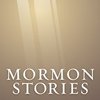Sunday in Outer Blogness: Love the Winter Weather Edition!
OK, today’s title is not related to this week’s posts (except maybe these). I was just sipping my tea and gazing out my window at the beautiful snow-covered roofs and trees, and thought: time for a relaxing afternoon of reading blogs!
Andrew Sullivan wrote an interesting thought experiment: What if Obama were a member of a church that has as much history of racism (against whites) as Mormonism does against blacks — would the press have been as polite about it as they were about Romney’s Mormonism? I say probably not, but I think this is largely because those media outlets who were playing Jeremiah Wright’s “God damn America” quote in a loop have just given up any semblance of treating their audience like reasonable, intelligent people.
In his thought experiment, Sullivan mistakenly confused the Lamanites’ curse (explained in the Book of Mormon) with the curse of Cain (through the lineage of Ham, as explained in Pearl of Great Price). OMG, how ignorant can you get, mistaking one Mormon racial-darkening curse with an entirely different one?! True to form, Joanna Brooks wrote an indignant can’t-see-the-forest-for-the-trees about how the curse of Cain and Ham — and corresponding restriction on the priesthood — isn’t in the Book of Mormon. Curiously, she neglected to mention the (extremely relevant) fact that that doctrine is in the Pearl of Great Price. From her “correction” you’d think Sullivan was wrong to claim that the Mormon doctrines about the curse of Cain are in the canon of Mormon scriptures. And you’d be wrong.
This is my my #1 biggest pet peeve about modern Mormonism. The faithful constantly insist that they are the only ones qualified to pronounce on Mormonism — yet they somehow can’t bring themselves to give clear, complete, and accurate information. I would like to believe that you can be a practising Mormon without checking your integrity at the door. It would be interesting to see if such a person ever gets a hold of the microphone. (For example, it looks like this correction is right, whereas I think this complaint is another example of missing the forest for the trees — do you agree?)
The biggest discussion category this week was gender, starting with that eternal conundrum — can gender really be eternal? And an even more interesting one: The CoJCoL-dS measures the health of a ward or branch according to the activity level of the adult men. Many commenters wondered why the women’s activity rate was not considered important, but — duh! — a congregation needs leaders, and women aren’t allowed in those roles. In CoJC-L-dS branch of Mormonism, that is — it’s a bit of a different story in another LDS tradition and for former Mormons. In other gender stories, one Mormon lady is taking her own identity back (long after a divorce) and others are praying to Heavenly Mother. Meanwhile, the Mormons are still teaching gay people that they can (and should!) overcome their homosexuality. Sounds like we could really use this improved Family Proclamation!!
Mormon Think got a new editor — a guy who went public about his secret second anointing ordinance. And the earlier editor is still writing interesting pieces.
There were several interesting posts about the Middle East this past week, including some historical information about David O. McKay’s early experiences in Israel, plus a Mormon living in the Middle East posted some amusing items from Mormon culture, plus some news on people convicted of blasphemy.
In personal stories, we have a baptism that the father could not perform, a fantasy holiday dinner, and a very weird lesson learned in church. And don’t miss exmo movie night!!
Happy reading!!













































Regarding Johanna Brooks piece, where she writes, “Romney’s attitudes on the priesthood ban are reflective of Romney’s own deeply embedded sense of loyalty to hierarchy and identification with institutional power.”, it seems to me she could write in her own name.
And if there were a Yosemite valley apologetics , I wouldn’t understand a massive production over confusing a Jeffery with a ponderosa, while not noticing the geologic formations.
It’s not that the forest is being missed(or even yellow pine), it’s not noticing El Capitan.
Yeah, Mormons won’t apologize for the ban because of how this would cut into priesthood infallibility, so they apologize for amorphous racism. But to not allow racism to be located in the Book of Mormon & associated texts, and leaders’ reading of these texts, is also unhelpful. I mean, if you want to suggest the curse of Cain does not “actually” refer to black people, and that this was a misreading of holy documents by leaders and lay folks alike, then fine. However, I’m sure that there are transcripts out there of high-level church leaders making a direction connection between the texts and the ban, which is worth bringing forward. Sullivan is trying to do this; Brooks seems like she just wants to clear the slate in some direct way. The thing about racism is that it can’t just be swept away.
Seriously, how about the belief that the Lamanites were ancestors of indigenous populations, that God loves American democracy, and therefore European colonialism was something that needed to happen (so that a light-skinned angel might visit a light-skinned Joseph Smith in the mid-nineteenth century and remake the one true church in these latter-days)? To me, this is the ultimate racism of the Book of Mormon. Even the phrase “latter-days” is racist, because it asserts an otherwordly end-times while ignoring/forgetting the true violence upon which it rests (a history of genocide). I know there are some Native American Mormons out there who deal with this contradiction, but if the Church is only just now dealing with its restriction on black priesthood, it’s going to be a long time before it gives much thought to colonialism. The Church is quite eager to expand wherever it can. Brooks says, “But there never was a restriction on Native Americans and Latinos!” It’s interesting how this fact is used to suggest that the Church was not that bad with regard to race.
@1 No doubt! And when she writes “Many Mormons today are still not comfortable saying “we were wrong.†This is reflective of a deeply traditional LDS reverence for Church authority, a historically-rooted guardedness against criticism by non-Mormon outsiders, and, for some, a belief in prophetic infallibility” — that may be accurate, but she’s not exactly paying Mormons a compliment.
@2 It’s true that the Pearl of Great Price doesn’t explicitly state that the curse of Cain equals black people. That’s the one missing link — it does state that the curse of Cain was preserved through the flood through the wife of Noah’s son Ham, and that Pharaoh, being of the lineage of Ham, couldn’t hold the priesthood.
However, even if we grant that Joseph Smith was translating ancient records, he was translating them into language he and his readers would understand. The text didn’t have to explicitly state “Descendants of Ham = Africans” because that’s what that meant to 19th century American Christians.
Joanna Brooks demonstrated that she’s well aware of the connection with “biblical narratives of Cain and Ham” (and the way those narratives were understood by nineteenth-century white American Christians), and yet she failed to mention that these nineteenth-century beliefs about Cain and Ham were preserved well into the late 20th century because they were included in the Mormon scriptures. That demonstrates a level of disingenuousness worthy of the LDS newsroom.
I assume she chooses not to mention the Pearl of Great Price — going out of her way to skirt around it — because the PR department is busy trying to pretend like it doesn’t exist (or at least that it’s not relevant to modern Mormons). But these passages were very relevant for justifying the priesthood ban, and they’ve never been disavowed or even clarified by the leadership since the lifting of the ban.